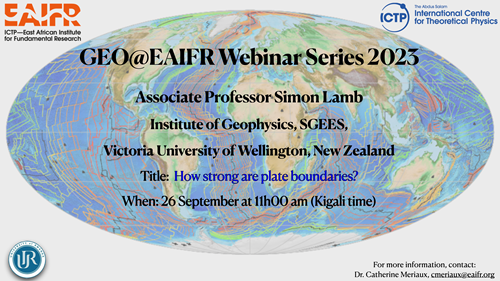ICTP-East African Institute for Fundamental Research
KIST2 Building CST
Nyarugenge Campus
University of Rwanda
Kigali, Rwanda
GEO@EAIFR Webinar Series 2023
Associate Professor Simon Lamb from the Institute of Geophysics, SGEES, Victoria at University of Wellington, Wellington, New Zealand will discuss how strong are plate boundaries.

The East African Institute for Fundamental Research (EAIFR) and the International Centre for Theoretical Physics (ICTP) wish to inform those who may be interested of a GEO@EAIFR webinar. This seminar will take place on September 26, 2023 and will be broadcast live on ZOOM. It will also be recorded and later posted on the ICTP-EAIFR YouTube channel, where one can find the previous recorded GEO@EAIFR webinars. Below all the details:
Speaker: Associate Professor Simon Lamb, Institute of Geophysics, SGEES, Victoria University of Wellington, Wellington, New Zealand. Email: Simon.Lamb@vuw.ac.nz
Title: How strong are plate boundaries?
When: September 26, 2023 at 11:00 am (Kigali time).
Register in advance for this meeting by clicking here.
All are very welcome.
Biography: Simon lamb is Associate Professor in Geophysics at Victoria University of Wellington, New Zealand. His research has focused on the tectonics of active plate boundaries using a wide range of techniques including analysis of earthquakes, GNSS (GPS) data, paleomagnetism, structural geology, and gravity surveys. He has worked in many plate boundaries, such as the Alpine-Himalayan belt, Central Andes and New Zealand. Prior to going to New Zealand, he was a lecturer in the Department of Earth Sciences at Oxford University, and also fellow of St Anne’s and St Cross colleges. While at Oxford, he was leader of a major project studying the Cenozoic evolution of the Central Andes in northern Chile and Bolivia. Since then, he has focused on the implications of interseismic GNSS observations for understanding stress/strain build-up and earthquakes in New Zealand. He was also co-leader of a major initiative sponsored by both Oxford University and Victoria University of Wellington to communicate the science of climate change to a wide audience.
Abstract: Virtually all earthquakes on Earth are associated with the boundaries of the tectonic plates, and most are in subduction zones. These earthquakes occur when the stresses in the plate boundary exceed the strength of rocks. Hence, an important parameter in understanding when earthquakes are likely to occur is the strength of the plate boundaries. The change in stress (stress drop) on a fault during an earthquake can be determined from both seismological and geodetic techniques, but the actual level of stress is still a matter of debate. A useful calibration of these stresses are the stresses due to gravity calculated from the density structure and topography of the lithosphere. I use the marked variation in height of the Andes along the western margin of South America, where the Nazca plate is being subducted beneath the South American plate, to estimate the strength of the megathrust in the subduction zone. The pattern of neotectonic deformation and simple force balance models show that the strength of the megathrust is essentially balanced by the weight of the mountains in the overlying plate. The conclusion of this work, when combined with a global analysis of subduction zones, is that megathrusts are extremely weak and must be lubricated by the subduction of wet sediment, with pore fluid pressures generally greater than 95% lithostatic. The unusually high mountains in the Central Andes require a stronger megathrust – although still very weak – most easily explained as a consequence climate-controlled sediment starvation of the trench, depriving the megathrust of some of its lubricant.
The full spatial distribution of stress and strength in a plate boundary zone can be calculated from the pattern of strain rate and lithospheric gravitational potential energy, in the context of a thin sheet viscous model of deformation. Using the obliquely converging New Zealand plate boundary zone as an example, I show that typical stresses driving earthquakes are similar to the stress drops during earthquakes, in the range 10 – 20 MPa, implying bulk lithospheric viscosities of about 1021 Pa s. Such low strengths suggest that earthquakes nucleate on fractures which locally have high pore fluid pressures, forming the weakest part of the crust within a stronger framework where hydrostatic conditions may occur.



